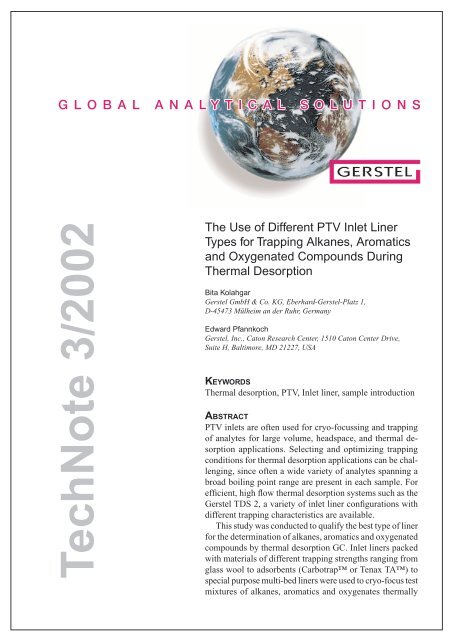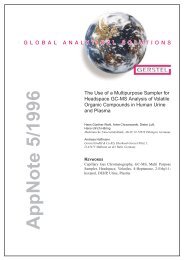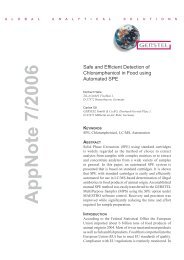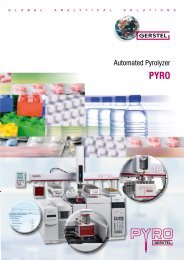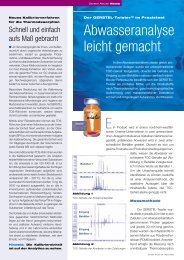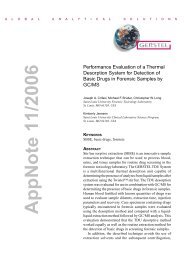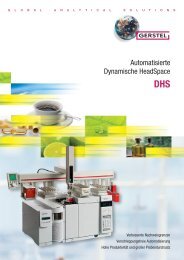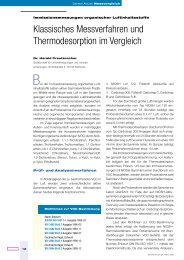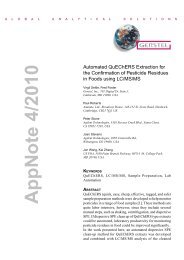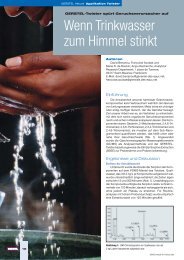TechNote-2002-03 - Gerstel
TechNote-2002-03 - Gerstel
TechNote-2002-03 - Gerstel
Create successful ePaper yourself
Turn your PDF publications into a flip-book with our unique Google optimized e-Paper software.
<strong>TechNote</strong> 3/<strong>2002</strong><br />
The Use of Different PTV Inlet Liner<br />
Types for Trapping Alkanes, Aromatics<br />
and Oxygenated Compounds During<br />
Thermal Desorption<br />
Bita Kolahgar<br />
<strong>Gerstel</strong> GmbH & Co. KG, Eberhard-<strong>Gerstel</strong>-Platz 1,<br />
D-45473 Mülheim an der Ruhr, Germany<br />
Edward Pfannkoch<br />
<strong>Gerstel</strong>, Inc., Caton Research Center, 1510 Caton Center Drive,<br />
Suite H, Baltimore, MD 21227, USA<br />
KEYWORDS<br />
Thermal desorption, PTV, Inlet liner, sample introduction<br />
ABSTRACT<br />
PTV inlets are often used for cryo-focussing and trapping<br />
of analytes for large volume, headspace, and thermal desorption<br />
applications. Selecting and optimizing trapping<br />
conditions for thermal desorption applications can be challenging,<br />
since often a wide variety of analytes spanning a<br />
broad boiling point range are present in each sample. For<br />
efficient, high flow thermal desorption systems such as the<br />
<strong>Gerstel</strong> TDS 2, a variety of inlet liner configurations with<br />
different trapping characteristics are available.<br />
This study was conducted to qualify the best type of liner<br />
for the determination of alkanes, aromatics and oxygenated<br />
compounds by thermal desorption GC. Inlet liners packed<br />
with materials of different trapping strengths ranging from<br />
glass wool to adsorbents (Carbotrap or Tenax TA) to<br />
special purpose multi-bed liners were used to cryo-focus test<br />
mixtures of alkanes, aromatics and oxygenates thermally
desorbed from air sampling adsorbent tubes. The parameters<br />
trapping temperature and desorption flow were<br />
optimized for the best trapping efficiency. Guidelines<br />
are given for choosing appropriate trapping conditions<br />
for these analyte classes.<br />
for the analyte range of interest. This study provides<br />
a set of guidelines for selecting inlet liner type and<br />
trapping conditions for aliphatic, aromatic and oxygenated<br />
organic compounds with boiling points between<br />
80°C and 290°C.<br />
INTRODUCTION<br />
A number of GC sample introduction techniques benefit<br />
by a pre-focussing step prior to separation on the<br />
analytical column. Although this can sometimes be<br />
accomplished by using a cryogenic cooling device on<br />
the head of the column itself, this technique has several<br />
limitations. First, the flow through the cooled region is<br />
limited to column flow, therefore sample introduction<br />
techniques that benefit by high flow (such as thermal<br />
desorption, purge and trap and online sampling) require<br />
a significant split of the sample flow ahead of the<br />
column. This severely limits sample load on-column.<br />
Second, trapping at sub-zero temperatures in a narrowbore<br />
capillary is prone to blockage due to freezing of<br />
water. Third, trapping on the column will also trap contaminants,<br />
impurities and other undesirable materials<br />
on the analytical column, often necessitating cutting<br />
sections from the head of the column to eliminate this<br />
interfering material.<br />
A programmed temperature vaporizing inlet (PTV)<br />
can be used to refocus analytes before introduction<br />
onto the analytical column. Using this technique, the<br />
entire sample stream, whether it be headspace injection<br />
or high gas flow from thermal desorption, purge and<br />
trap or online sampling, is passed through the trapping<br />
region in the inlet prior to the split vent. If trapping<br />
conditions are properly chosen then the entire sample<br />
will be trapped in the inlet liner before the high gas<br />
flow exits via the split vent. Since trapping is done in<br />
the inlet liner which has a much larger internal diameter<br />
than a GC column it is much less prone to blockage due<br />
to freezing. Also, any low-volatility contaminants that<br />
may be trapped along with the sample accumulate in<br />
the easily replaced inlet liner, protecting the integrity<br />
of the analytical column.<br />
The first step in selecting appropriate trapping conditions<br />
is the choice of inlet liner. Several types of inlet<br />
liners are commercially available, ranging from inert<br />
supports (glass or quartz wool) to chemical adsorbents<br />
(Tenax TA or Carbotrap). Custom combinations<br />
of adsorbents can also be prepared to meet special application<br />
needs. Once a liner type is chosen, trapping<br />
conditions (flow and temperature) must be optimized<br />
EXPERIMENTAL<br />
Instrumentation. All analyses were performed on a<br />
GC (6890, Agilent Technologies) with mass selective<br />
detection (5973, Agilent Technologies) equipped with<br />
a Thermal Desorption system with autosampler (TDS2<br />
& TDSA, <strong>Gerstel</strong>) and a PTV inlet (CIS4, <strong>Gerstel</strong>).<br />
Analysis Conditions.<br />
TDS 2 Tube Tenax TA, 60/80 mesh<br />
splitless<br />
20°C, 60°C/min, 280°C (5 min)<br />
PTV insert type: see figures<br />
solvent vent flow: see figures,<br />
split ratio 30:1<br />
initial temp: see figures,<br />
12°C/s, 280°C (3 min)<br />
Column 30m HP-5 (Agilent),<br />
d i<br />
= 0.25mm, d f<br />
= 0.25mm<br />
Pneumatics He, constant flow = 1.0 mL/min<br />
Oven 40°C (1 min), 10°C/min, 300°C<br />
MSD scan, 35-300 amu<br />
All data were analyzed by using target ions in the extracted<br />
ion mode. The molecular ions of the compounds<br />
are used as target ions (see Table 1).<br />
Standard preparation. A standard mixture of 14 compounds<br />
(alkanes, aromatics and oxygenated VOCs) at a<br />
concentration of 2 mg/mL in hexane was prepared for<br />
this study. The compounds investigated in this study<br />
are listed in table 1.<br />
Sampling. Gas sampling TDS tubes filled with Tenax<br />
TA were spiked with the standard mixture. For this<br />
purpose, 1 μL of the standard was injected through a<br />
<strong>Gerstel</strong> septumless sampling head on the Tenax bed.<br />
The tubes were purged 8 min with a helium flow of 400<br />
mL/min during and after the injections. Afterwards the<br />
tubes were placed in the TDS autosampler for ther mal<br />
desorption and the subsequent GC/MS analysis.<br />
TN/<strong>2002</strong>/<strong>03</strong> - 2
Table 1. Investigated compounds.<br />
Compound BP [°C] Target Ion<br />
Benzene 80 78<br />
Heptane 98 43<br />
Toluene 110 91<br />
Acetic acid butyl ester 125 43<br />
Octane 126 43<br />
o-Xylene 144 91<br />
Nonane 151 43<br />
Decane 174 43<br />
1,2,3-Trimethylbenzene 175 105<br />
Acetophenone 202 105<br />
Dodecane 216 57<br />
Tetradecane 252 57<br />
Pentadecane 270 57<br />
Hexadecane 287 57<br />
Note: Throughout the following fi gures, aliphatics are shown in black;<br />
aromatics in blue , and oxygenates in red.<br />
Figure 1 shows a total ion chromatogram of the standard<br />
mixture.<br />
Variation of cryo-focussing temperature. All spiked<br />
Tenax TDS tubes were desorbed using the same desorption<br />
conditions. The cryo-focussing of the compounds<br />
during thermal desorption was performed at 3 different<br />
temperatures (-150°C, -40°C, 10°C). In the case of<br />
CIS liners filled with Tenax TA, cryo-focussing was<br />
performed at -40°C and 10°C. The cryo-focussing<br />
temperature yielding the highest peak area was judged<br />
to be the best.<br />
Variation of desorption fl ow. Using the optimized<br />
cryo-focussing temperature, the desorption flow was<br />
varied: 70 mL/min, 50 mL/min, and 30 mL/min. The<br />
desorption flow yielding the highest peak area was<br />
judged to be the best.<br />
Abundance<br />
1.5e+07<br />
1e+07<br />
Benzene<br />
Heptane<br />
Toluene<br />
Octane<br />
Acetic acid butyl ester<br />
o-Xylene<br />
Nonane<br />
1,2,3-Trimethylbenzene<br />
Decane<br />
Acetophenone<br />
Dodecane<br />
Tetradecane<br />
Pentadecane<br />
Hexadecane<br />
5000000<br />
Time--> 2.00 4.00 6.00 8.00 10.00 12.00 14.00<br />
Figure 1. Total ion chromatogram of the standard mixture.<br />
TN/<strong>2002</strong>/<strong>03</strong> - 3
RESULTS AND DISCUSSION<br />
Cryotrapping on inert supports. The simplest approach<br />
to pre-focussing analytes in a PTV inlet is to cryotrap<br />
onto inert supports. Glass wool and quartz wool packed<br />
inlet liners provide sufficient surface area to trap<br />
volatile analytes when cooled cryogenically. Quartz<br />
wool contains fewer impurities than glass wool, and<br />
therefore may be more inert toward some analyte types.<br />
Both glass and quartz wool are deactivated by silaniza-<br />
tion to further passivate the surfaces. Pesticide grade<br />
glass wool packed inlet liners are specially deactivated<br />
after the glass wool is inserted into the liner.<br />
The results of cryotrapping on inert supports with<br />
different cryo-focussing temperatures and different desorption<br />
flows are shown in figures 2 – 4. The columns<br />
in the diagrams are averages of 3 measurements and<br />
the error bars indicate the standard deviations.<br />
12000000<br />
10000000<br />
A<br />
Peak Area<br />
8000000<br />
6000000<br />
4000000<br />
-150 C<br />
-40 C<br />
10 C<br />
2000000<br />
0<br />
14000000<br />
12000000<br />
Heptane<br />
Octane<br />
Nonane<br />
Decane<br />
Dodecane<br />
Tetradecane<br />
Pentadecane<br />
Hexadecane<br />
Acetic acid<br />
butyl ester<br />
Acetophenone<br />
Benzene<br />
Toluene<br />
o-Xylene<br />
1,2,3-Trimethylbenzene<br />
B<br />
10000000<br />
Peak Area<br />
8000000<br />
6000000<br />
4000000<br />
70 mL/min<br />
50 mL/min<br />
30 mL/min<br />
2000000<br />
0<br />
Heptane<br />
Octane<br />
Nonane<br />
Decane<br />
Dodecane<br />
Tetradecane<br />
Pentadecane<br />
Hexadecane<br />
Acetic acid<br />
butyl ester<br />
Acetophenone<br />
Benzene<br />
Toluene<br />
o-Xylene<br />
1,2,3-Trimethylbenzene<br />
Figure 2. Variation of cryo-focussing temperature (A) and desorption flow (B) using a deactivated glass wool<br />
liner.<br />
TN/<strong>2002</strong>/<strong>03</strong> - 4
16000000<br />
14000000<br />
A<br />
12000000<br />
Peak Area<br />
10000000<br />
8000000<br />
6000000<br />
-150 C<br />
-40 C<br />
10 C<br />
4000000<br />
2000000<br />
0<br />
16000000<br />
14000000<br />
Heptane<br />
Octane<br />
Nonane<br />
Decane<br />
Dodecane<br />
Tetradecane<br />
Pentadecane<br />
Hexadecane<br />
Acetic acid<br />
butyl ester<br />
Acetophenone<br />
Benzene<br />
Toluene<br />
o-Xylene<br />
1,2,3-Trimethylbenzene<br />
B<br />
12000000<br />
Peak Area<br />
10000000<br />
8000000<br />
6000000<br />
70 mL/min<br />
50 mL/min<br />
30 mL/min<br />
4000000<br />
2000000<br />
0<br />
Heptane<br />
Octane<br />
Nonane<br />
Decane<br />
Dodecane<br />
Tetradecane<br />
Pentadecane<br />
Hexadecane<br />
Acetic acid<br />
butyl ester<br />
Acetophenone<br />
Benzene<br />
Toluene<br />
o-Xylene<br />
1,2,3-Trimethylbenzene<br />
Figure 3. Variation of cryo-focussing temperature (A) and desorption flow (B) using a quartz wool liner.<br />
TN/<strong>2002</strong>/<strong>03</strong> - 5
20000000<br />
18000000<br />
16000000<br />
A<br />
Peak Area<br />
14000000<br />
12000000<br />
10000000<br />
8000000<br />
6000000<br />
4000000<br />
2000000<br />
-150 C<br />
-40 C<br />
10 C<br />
0<br />
25000000<br />
20000000<br />
Heptane<br />
Octane<br />
Nonane<br />
Decane<br />
Dodecane<br />
Tetradecane<br />
Pentadecane<br />
Hexadecane<br />
Acetic acid<br />
butyl ester<br />
Acetophenone<br />
Benzene<br />
Toluene<br />
o-Xylene<br />
1,2,3-Trimethylbenzene<br />
B<br />
Peak Area<br />
15000000<br />
10000000<br />
70 mL/min<br />
50 mL/min<br />
30 mL/min<br />
5000000<br />
0<br />
Heptane<br />
Octane<br />
Nonane<br />
Decane<br />
Dodecane<br />
Tetradecane<br />
Pentadecane<br />
Hexadecane<br />
Acetic acid<br />
butyl ester<br />
Acetophenone<br />
Benzene<br />
Toluene<br />
o-Xylene<br />
1,2,3-Trimethylbenzene<br />
Figure 4. Variation of cryo-focussing temperature (A) and desorption flow (B) using a silanized glass wool<br />
liner.<br />
As might be expected, the coldest temperature (-150°C)<br />
provided the best cryotrapping on inert supports for<br />
the wide range of test compounds. A slight tendency<br />
toward better trapping with low flow (30 mL/min)<br />
was seen, although the amount of improvement was<br />
mar gi nal. In general, the inert supports gave reasonably<br />
consistent trapping efficiency for oxygenates,<br />
aromatics, and C10 and higher alkanes.<br />
Interestingly, both quartz wool and silanized glass<br />
wool showed better trapping efficiency at higher temperatures<br />
than seen for the deactivated glass wool,<br />
TN/<strong>2002</strong>/<strong>03</strong> - 6<br />
particularly for shorter chain alkanes, oxygenates and<br />
aromatics. One possibility to explain this difference is<br />
that the pesticide-grade deactivated glass wool liner is<br />
treated after the wool is packed into the liner therefore<br />
all surfaces are more completely passivated. For the<br />
other liners, the quartz and glass wool is silanized with<br />
a different process before packing, which may result<br />
in slightly different coating density or thickness. The<br />
pesticide-grade deactivated glass wool liner gave the<br />
best peak shapes of all liners tested (Figure 9).
Focussing on chemical adsorbents. If no cryogenic liquids<br />
are available, or if samples contain high moisture<br />
levels or very low boiling organics then an inlet liner<br />
packed with an adsorbent may be necessary. Tenax<br />
TA is a porous polymer designed to trap C5-C26<br />
organics without retaining water. Carbotrap is a<br />
non-porous graphitized carbon black designed to trap<br />
C5-C12 organics. Both are available as prepacked inlet<br />
liners for the PTV inlet.<br />
The results of cryotrapping on adsorbent-packed<br />
inlet liners with different cryo-focussing temperatures<br />
and different desorption flows are shown in figures<br />
5-7. The columns in the diagrams are averages of 3<br />
measurements and the error bars indicate the standard<br />
deviations.<br />
The lower temperature limit for Tenax TA is about<br />
-50°C therefore trapping was only tested at 10°C and<br />
–40°C. Using a Tenax liner, the best results were obtained<br />
at a cryo-focussing temperature of -40°C and<br />
a desorption flow of 70 mL/min (Figure 5). Neither<br />
trapping temperature nor desorption flow made a significant<br />
difference in the range tested. Similar trapping<br />
efficiency for the oxygenates and aromatics was seen<br />
for Tenax TA and cryotrapping on inert supports.<br />
25000000<br />
20000000<br />
A<br />
Peak Area<br />
15000000<br />
10000000<br />
-40 C<br />
10 C<br />
5000000<br />
0<br />
25000000<br />
20000000<br />
Heptane<br />
Octane<br />
Nonane<br />
Decane<br />
Dodecane<br />
Tetradecane<br />
Pentadecane<br />
Hexadecane<br />
Acetic acid<br />
butyl ester<br />
Acetophenone<br />
Benzene<br />
Toluene<br />
o-Xylene<br />
1,2,3-Trimethylbenzene<br />
B<br />
Peak Area<br />
15000000<br />
10000000<br />
70 mL/min<br />
50 mL/min<br />
30 mL/min<br />
5000000<br />
0<br />
Heptane<br />
Octane<br />
Nonane<br />
Decane<br />
Dodecane<br />
Tetradecane<br />
Pentadecane<br />
Hexadecane<br />
Acetic acid<br />
butyl ester<br />
Acetophenone<br />
Benzene<br />
Toluene<br />
o-Xylene<br />
1,2,3-Trimethylbenzene<br />
Figure 5. Variation of cryo-focussing temperature (A) and desorption flow (B) using a Tenax liner.<br />
TN/<strong>2002</strong>/<strong>03</strong> - 7
A significant difference was seen for the long chain<br />
alkanes, however. On the inert adsorbents the long<br />
chain alkanes were generally more efficiently trapped<br />
than the short chain alkanes, but on Tenax TA the<br />
response for long chain (C14 and higher) alkanes was<br />
poorer than the short chain alkanes. This is due to<br />
insufficient desorption of these compounds from the<br />
porous Tenax TA at a desorption temperature of<br />
300°C used in this study. It should be mentioned that<br />
300°C is nearly the temperature limit for Tenax. The<br />
low peak size for C14-C16 on Tenax is more likely due<br />
to poor recovery of these compound on Tenax. This<br />
was manifested by carryover problems.<br />
The Carbotrap liner performed well for nearly<br />
all compounds in the study (Figure 6) at all trapping<br />
temperatures used. Long chain alkane trapping and<br />
recovery was better than for Tenax TA, although a<br />
slight drop in response for hexadecane was seen, particularly<br />
at -150°C. The better performance for the long<br />
chain alkanes compared to Tenax TA is probably due<br />
to the improved recovery from the nonporous particles<br />
compared to the porous polymer.<br />
18000000<br />
16000000<br />
14000000<br />
A<br />
Peak Area<br />
12000000<br />
10000000<br />
8000000<br />
6000000<br />
4000000<br />
2000000<br />
-150 C<br />
-40 C<br />
10 C<br />
0<br />
18000000<br />
16000000<br />
14000000<br />
Heptane<br />
Octane<br />
Nonane<br />
Decane<br />
Dodecane<br />
Tetradecane<br />
Pentadecane<br />
Hexadecane<br />
Acetic acid<br />
butyl ester<br />
Acetophenone<br />
Benzene<br />
Toluene<br />
o-Xylene<br />
1,2,3-Trimethylbenzene<br />
B<br />
12000000<br />
Peak Area<br />
10000000<br />
8000000<br />
6000000<br />
4000000<br />
2000000<br />
70 mL/min<br />
50 mL/min<br />
30 mL/min<br />
0<br />
Heptane<br />
Octane<br />
Nonane<br />
Decane<br />
Dodecane<br />
Tetradecane<br />
Pentadecane<br />
Hexadecane<br />
Acetic acid<br />
butyl ester<br />
Acetophenone<br />
Benzene<br />
Toluene<br />
o-Xylene<br />
1,2,3-Trimethylbenzene<br />
Figure 6. Variation of cryo-focussing temperature (A) and desorption flow (B) using a Carbotrap liner.<br />
TN/<strong>2002</strong>/<strong>03</strong> - 8
When a mixed-bed liner (Tenax TA + Carbotrap)<br />
was prepared and tested, the results closely paralleled<br />
the results for Tenax TA alone (Figure 7). Since<br />
Tenax is the first adsorbent on the liner in the carrier<br />
gas flow direction, the adsorption of the compounds<br />
during trapping is dominated by Tenax giving results<br />
similar to using pure Tenax TA (compare figures 5<br />
and 7).<br />
18000000<br />
16000000<br />
14000000<br />
A<br />
Peak Area<br />
12000000<br />
10000000<br />
8000000<br />
6000000<br />
4000000<br />
2000000<br />
-40 C<br />
10 C<br />
0<br />
18000000<br />
16000000<br />
14000000<br />
Heptane<br />
Octane<br />
Nonane<br />
Decane<br />
Dodecane<br />
Tetradecane<br />
Pentadecane<br />
Hexadecane<br />
Acetic acid<br />
butyl ester<br />
Acetophenone<br />
Benzene<br />
Toluene<br />
o-Xylene<br />
1,2,3-Trimethylbenzene<br />
B<br />
12000000<br />
Peak Area<br />
10000000<br />
8000000<br />
6000000<br />
4000000<br />
2000000<br />
70 mL/min<br />
50 mL/min<br />
30 mL/min<br />
0<br />
Heptane<br />
Octane<br />
Nonane<br />
Decane<br />
Dodecane<br />
Tetradecane<br />
Pentadecane<br />
Hexadecane<br />
Acetic acid<br />
butyl ester<br />
Acetophenone<br />
Benzene<br />
Toluene<br />
o-Xylene<br />
1,2,3-Trimethylbenzene<br />
Figure 7. Variation of cryo-focussing temperature (A) and desorption flow (B) using a Tenax & Carbotrap<br />
TN/<strong>2002</strong>/<strong>03</strong> - 9
Figure 8 shows the comparison of the results of the<br />
measurements performed with optimized parameters<br />
using different liners. In general, all the liners emplo-<br />
yed in this study are more efficient for trapping of the<br />
oxygenated and aromatic compounds than for trapping<br />
alkanes.<br />
25000000<br />
20000000<br />
Deactivated Glass Wool, -150 C, 30 mL/min<br />
Silanized Glass Wool, -150 C, 30 mL/min<br />
Carbotrap,10 C,50 mL/min<br />
Quartz Wool , -150 C, 30 mL/min<br />
Tenax,-40 C,70 mL/min<br />
Tenax & Carbotrap,10 C,50 mL/min<br />
15000000<br />
10000000<br />
5000000<br />
0<br />
Heptane<br />
Octane<br />
Nonane<br />
Decane<br />
Dodecane<br />
Tetradecane<br />
Pentadecane<br />
Hexadecane<br />
Acetic acid<br />
butyl ester<br />
Acetophenone<br />
Benzene<br />
Toluene<br />
o-Xylene<br />
1,2,3-Trimethylbenzene<br />
Figure 8. Summary of the results obtained with different liner.<br />
Based on the recovered peak areas, the best results<br />
were obtained as follows:<br />
• benzene, heptane, toluene, o-xylene, nonane,<br />
1,2,3-tri-methylbenzene, and dodecane using a<br />
silanized glass wool liner at –150°C and<br />
30 mL/min.<br />
• octane and tetradecane using a carbotrap liner at<br />
10°C and 50 mL/min.<br />
• acetic acid butyl ester, acetophenone and decane<br />
using a Tenax liner at -40°C and 70 mL/min.<br />
• pentadecane using a quartz wool liner at –150°C<br />
and 30 mL/min.<br />
• hexadecane using deactivated glass wool at –150°C<br />
and 30 mL/min.<br />
Liner effect on chromatography. Looking into the<br />
chromatograms and the peak shapes (see Figure 9) we<br />
can see that the best peak shape is obtained using the<br />
deactivated glass wool liner. The strong adsorption of<br />
the compounds on Tenax TA and Carbotrap lead to<br />
inefficient desorption of the analytes during injection,<br />
which leads to peak broadening and/or peak splitting.<br />
This might be the reason for the poor recovery of octane<br />
on the Tenax TA liner. Peak broadening and splitting<br />
make integration of the peaks more difficult and can<br />
lead to misinterpretation of the data.<br />
It should be mentioned that a quite high split ratio<br />
(30:1), which provides a high carrier gas flow through<br />
the injector liner, is used for the measurements<br />
performed in this study. Using the splitless injection<br />
mode, the carrier gas flow through the injector would<br />
be below 5 mL/min, which leads to a slow transfer of<br />
the compounds to the column and to an even greater<br />
deterioration of the peak shape when using adsorbents<br />
for trapping.<br />
TN/<strong>2002</strong>/<strong>03</strong> - 10
Abundance<br />
1e+07<br />
Tenax & Carbotrap<br />
1e+07<br />
Carbotrap<br />
1e+07<br />
Tenax<br />
1e+07<br />
Silanized glass wool<br />
1e+07<br />
Quartz wool<br />
1e+07<br />
Deactivated glass wool<br />
Time--> 5.00 10.00<br />
15.00 20.00<br />
25.00<br />
Figure 9. Chromatograms of the measurements performed with different liner and the optimized cryo-focussing<br />
temperature and desorption flow.<br />
If adsorbent packed liners are used to trap low boiling<br />
compounds, then the best strategy is to use a thick<br />
film column to provide adequate focussing on the head<br />
of the column after transfer from the inlet. This also<br />
will provide better retention and resolution of the low<br />
boiling compounds.<br />
CONCLUSIONS<br />
The best results concerning both peak shape and<br />
recovery throughout all compounds were achieved<br />
using the pesticide-grade deactivated glass wool liner.<br />
Using this liner type a cryo-focussing temperature<br />
of –150°C is required to trap aromatics, and alkanes<br />
down to C7.<br />
If CIS systems with cryostat (temperature limit:<br />
-40°C) or Peltier cooling (temperature limit: 10°C<br />
below room temperature) are used, Tenax TA or<br />
Carbotrap filled liner should be applied. Using<br />
adsorbent packed liners, adequate flow (>6 mL/min)<br />
through the liner during heating is necessary to obtain<br />
good peak shapes.<br />
If the sample contains moisture or other polar impurities,<br />
Tenax TA might be the more appropriate<br />
packing material. Tenax does not adsorb water and<br />
polar impurities and therefore prevents freezing of the<br />
CIS during trapping.<br />
TN/<strong>2002</strong>/<strong>03</strong> - 11
GERSTEL GmbH & Co. KG<br />
Eberhard-<strong>Gerstel</strong>-Platz 1<br />
D-45473 Mülheim an der Ruhr<br />
Germany<br />
+49 (0) 208 - 7 65 <strong>03</strong>-0<br />
+49 (0) 208 - 7 65 <strong>03</strong> 33<br />
gerstel@gerstel.com<br />
www.gerstel.com<br />
GERSTEL Worldwide<br />
GERSTEL, Inc.<br />
701 Digital Drive, Suite J<br />
Linthicum, MD 21090<br />
USA<br />
+1 (410) 247 5885<br />
+1 (410) 247 5887<br />
sales@gerstelus.com<br />
www.gerstelus.com<br />
GERSTEL AG<br />
Wassergrabe 27<br />
CH-6210 Sursee<br />
Switzerland<br />
+41 (41) 9 21 97 23<br />
+41 (41) 9 21 97 25<br />
gerstel@ch.gerstel.com<br />
www.gerstel.ch<br />
GERSTEL K.K.<br />
1-3-1 Nakane, Meguro-ku<br />
Tokyo 152-0<strong>03</strong>1<br />
SMBC Toritsudai Ekimae Bldg 4F<br />
Japan<br />
+81 3 5731 5321<br />
+81 3 5731 5322<br />
info@gerstel.co.jp<br />
www.gerstel.co.jp<br />
GERSTEL LLP<br />
Level 25, North Tower<br />
One Raffles Quay<br />
Singapore 048583<br />
+65 6622 5486<br />
+65 6622 5999<br />
SEA@gerstel.com<br />
www.gerstel.com<br />
GERSTEL Brasil<br />
Av. Pascoal da Rocha Falcão, 367<br />
04785-000 São Paulo - SP Brasil<br />
+55 (11)5665-8931<br />
+55 (11)5666-9084<br />
gerstel-brasil@gerstel.com<br />
www.gerstel.com.br<br />
Information, descriptions and specifications in this<br />
Publication are subject to change without notice.<br />
GERSTEL, GRAPHPACK and TWISTER are registered<br />
trademarks of GERSTEL GmbH & Co. KG.<br />
© Copyright by GERSTEL GmbH & Co. KG<br />
Awarded for the<br />
active pursuit of<br />
environmental sustainability


